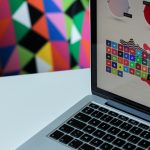When designing and merchandising a retail space, every retailer faces challenges. The main challenge is how to display and arrange products such that they are easy to find and appealing to the eye? The answer lies in the details, so we’ve compiled this list of visual merchandising elements.
Colour
Colour is crucial to how customers perceive a space. It is the visual carrier of information, and it directly affects how customers feel as they navigate the area.
For example, a space with red walls and a red merchandise display cabinet might make the customer feel warm and comfortable. In contrast, a space with green walls and the same red cabinet might induce feelings of calmness and serenity. The customer’s perception of the area is directly linked to their emotional response.
Colour can create visual hierarchy, create distinguishability among various product categories, and create a sense of style and identity for the space.
The right colour can also help draw in customers, who will subconsciously associate the color with the products inside the store.
Lighting
Lighting can affect the mood of the space and draw the customer’s eye toward the merchandise. Incandescent lights, for example, create a warm, soft, and inviting atmosphere, whereas LEDs deliver a cooler, more focused light. The type of lighting fixtures used can also affect how customers perceive the space.
When shopping in a space with dim lighting, customers might become distracted by other things, such as decorative elements, displays, or other customers. This can result in delayed purchases, lower sales, and a negative shopping experience.
However, when too much lighting is used, it can also have the opposite effect, causing customers to feel uncomfortable and jittery. The right amount of lighting can help create a calm, secure, and inviting atmosphere in the store.
Space planning
The layout and design of the storage space are crucial to creating a positive shopping experience. This includes factors such as the space’s height, length, width, and depth.
Thought should also be given to the store’s location in relation to its competitors. For example, a store near the entrance of an indoor shopping mall will exude more authority and attract more attention than one located in the back of the mall.
Graphic displays
Graphic elements such as signs, posters, and hand signs can augment the written and verbal communications that take place inside a store. Visual cues such as these can increase the overall awareness of the sales associates and assist in guiding customers to the right area of the store.
Another benefit of graphic elements is that they can convey special offers, coupons, and other information that the customer may be interested in, such as the feature or price of a product.
Visual cues
Visual cues are things such as colour, pattern, shape, and design that elicit a response from the brain and trigger a memory. They are used to help trigger the memory of a particular product or service and can direct customers to the product they are looking for or help them make a purchasing decision.
Retailers must remember that design is not just about the aesthetic appeal of a space. It is also about the functionality of the space and how it impacts the shopper’s experience. If a store is poorly designed, the customer might navigate through the aisles with difficulty, become frustrated, and ultimately leave the store without making a purchase.



